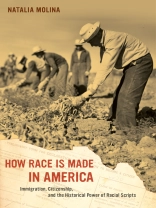How Race Is Made in America examines Mexican Americans—from 1924, when American law drastically reduced immigration into the United States, to 1965, when many quotas were abolished—to understand how broad themes of race and citizenship are constructed. These years shaped the emergence of what Natalia Molina describes as an
immigration regime
, which defined the racial categories that continue to influence perceptions in the United States about Mexican Americans, race, and ethnicity.
Molina demonstrates that despite the multiplicity of influences that help shape our concept of race, common themes prevail. Examining legal, political, social, and cultural sources related to immigration, she advances the theory that our understanding of race is socially constructed in relational ways—that is, in correspondence to other groups. Molina introduces and explains her central theory,
racial scripts
, which highlights the ways in which the lives of racialized groups are linked across time and space and thereby affect one another.
How Race Is Made in America also shows that these racial scripts are easily adopted and adapted
to apply to different racial groups.
Table of Content
List of Illustrations
Introduction
Part I. Immigration Regimes I: Mapping Race and Citizenship
Chapter One: Placing Mexican Immigration within the Larger Landscape of Race Relations in the U.S.
Chapter Two: ‘What is a White Man?’: The Quest to Make Mexicans Ineligible for U.S. Citizenship
Chapter Three: Birthright Citizenship Beyond Black and White
Part II. Immigration Regimes II: Making Mexicans Deportable
Chapter Four: Mexicans Suspended in a State of Deportability: Medical Racialization and Immigration Policy in the 1940s
Chapter Five: Deportations in the Urban Landscape
Epilogue: Making Race in the Twenty-First Century
Notes
Bibliography
About the author
Natalia Molina is Professor of American Studies and Ethnicity at University of Southern California and the recipient of a Mac Arthur Fellowship. She is the author of the award-winning Fit to Be Citizens?: Public Health and Race in Los Angeles, 1879-1940 and the co-editor of Relational Formations of Race: Theory, Method, and Practice.












